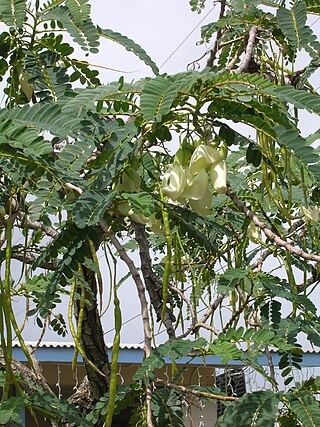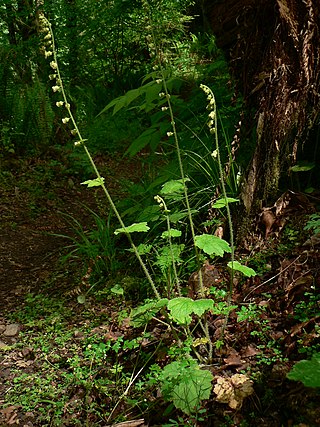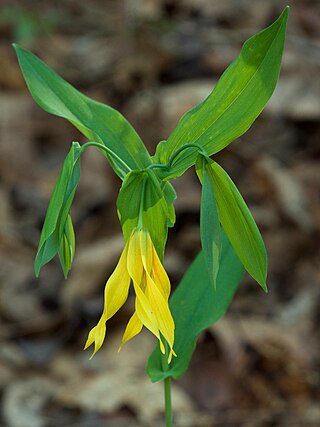
Magnolia grandiflora, commonly known as the southern magnolia or bull bay, is a tree of the family Magnoliaceae native to the Southeastern United States, from Virginia to central Florida, and west to East Texas. Reaching 27.5 m (90 ft) in height, it is a large, striking evergreen tree, with large, dark-green leaves up to 20 cm long and 12 cm wide, and large, white, fragrant flowers up to 30 cm (12 in) in diameter.

Thunbergia is a genus of flowering plants in the family Acanthaceae. It includes 150 species native to tropical and subtropical regions of sub-Saharan Africa, Madagascar, southern Asia, New Guinea, and Australia. Thunbergia species are vigorous annual or perennial vines and shrubs growing to 2–8 m tall. The generic name honours the Swedish naturalist Carl Peter Thunberg (1743-1828).

Sesbania grandiflora, commonly known as vegetable hummingbird, katurai, agati, or West Indian pea, is a small leguminous tree native to Maritime Southeast Asia and Northern Australia. It has edible flowers and leaves commonly eaten in Southeast Asia and South Asia.

Thespesia grandiflora, most commonly known as Maga, and also referred to as Maga Colorada and Puerto Rican hibiscus, is a tree in the family Malvaceae of the rosids clade endemic to Puerto Rico, where its flower is officially recognized as the national flower of the archipelago. Although originally native to the humid mountains of limestone in the western and north-central portions of Puerto Rico, today it grows everywhere in the archipelago due to its extensive cultivation. It is also grown as an ornamental tree in Florida, Hawaii, Honduras and various Caribbean islands. The maga is mostly used as an ornamental plant, but like the related Thespesia populnea its wood is also valued for its durable timber.

Portulaca grandiflora is a succulent flowering plant in the purslane family Portulacaceae, native to southern Brazil, Argentina, and Uruguay and often cultivated in gardens. It has many common names, including rose moss, eleven o'clock, Mexican rose, moss rose, sun rose, table rose, rock rose, and moss-rose purslane. Despite these names and the superficial resemblance of some cultivars' flowers to roses, it is not a true rose, nor even a part of the rose family or rosid group; rather, it is much more closely related to carnations and cacti.

Tellima grandiflora, the bigflower tellima or fringecups, is a herbaceous perennial flowering plant in the family Saxifragaceae. It is the only species in the genus Tellima.

Carbonic anhydrase inhibitors are a class of pharmaceuticals that suppress the activity of carbonic anhydrase. Their clinical use has been established as anti-glaucoma agents, diuretics, antiepileptics, in the management of mountain sickness, gastric and duodenal ulcers, idiopathic intracranial hypertension, neurological disorders, or osteoporosis.

Uvularia grandiflora, the large-flowered bellwort or merrybells, is a species of flowering plant in the family Colchicaceae, native to eastern and central North America.

Coreopsis grandiflora is a North American species of perennial plant in the family Asteraceae. The common name is large-flowered tickseed. It is found in eastern Canada and much of the United States, especially the south-central part of the country. The species is widely cultivated in China and naturalized there.

Casuarictin is an ellagitannin, a type of hydrolysable tannin. It can be found in Casuarina and Stachyurus species.

Tellimagrandin II is the first of the ellagitannins formed from 1,2,3,4,6-pentagalloyl-glucose. It can be found in Geum japonicum and Syzygium aromaticum (clove).
T. grandiflora may refer to:

Oreocallis is a South American plant genus in the family Proteaceae. There is only one species, Oreocallis grandiflora, which is native to mountainous regions in Peru and Ecuador.

Conradina grandiflora is a species of flowering plant in the mint family known by the common name largeflower false rosemary, or large-flowered rosemary. It is endemic to Florida in the United States, where it occurs on the Atlantic Coastal Ridge. Its distribution spans Brevard, Broward, Dade, Highlands, Indian River, Martin, Osceola, Palm Beach, Polk, St. Lucie, and Volusia Counties.
Greya punctiferella is a moth of the family Prodoxidae. It is found in the Pacific coastal ranges, the western slopes of the Cascades and in parts of the Sierra Nevada from south-eastern Alaska in the north to the Mendocino region of northern California in the south. The habitat consists of moist, coniferous or mixed conifer-Alnus forests.

Punicafolin is an ellagitannin from the leaves of Punica granatum (pomegranate) and in Phyllanthus emblica.

Casuarinin is an ellagitannin. It is found in the pericarp of pomegranates. It is also found in Casuarina and Stachyurus species and in Alnus sieboldiana.

4-O-Methylhonokiol is a neolignan, a type of phenolic compound. It is found in the bark of Magnolia grandiflora and in M. virginiana flowers.
Hexalectris grandiflora, the largeflower crested coralroot or giant coral-root, is a species of orchid native to Mexico from Chihuahua south to Oaxaca, as well as to western and north-central Texas. It is a myco-heterotrophic species, lacking chlorophyll and subsisting entirely on nutrients obtained by fungi in the soil.

Tellimagrandin I is an ellagitannin found in plants, such as Cornus canadensis, Eucalyptus globulus, Melaleuca styphelioides, Rosa rugosa, and walnut. It is composed of two galloyl and one hexahydroxydiphenyl groups bound to a glucose residue. It differs from Tellimagrandin II only by a hydroxyl group instead of a third galloyl group. It is also structurally similar to punigluconin and pedunculagin, two more ellagitannin monomers.

















